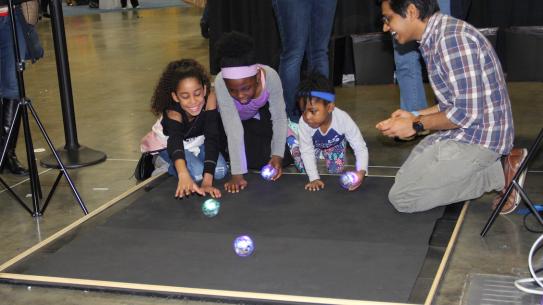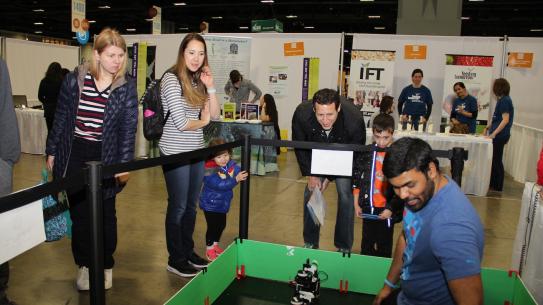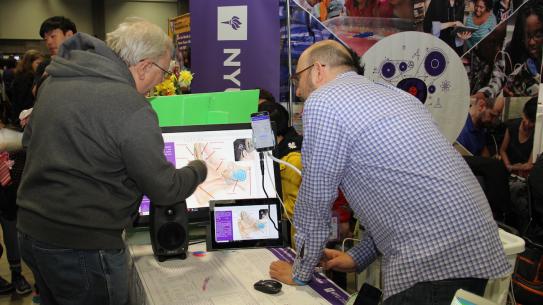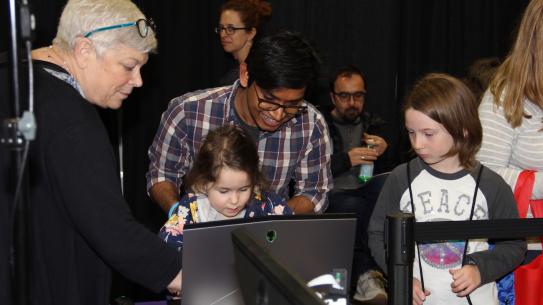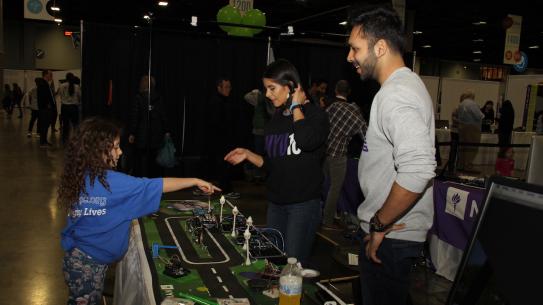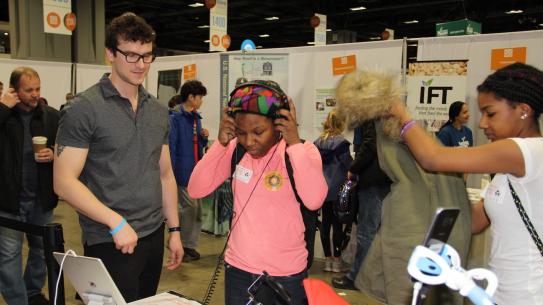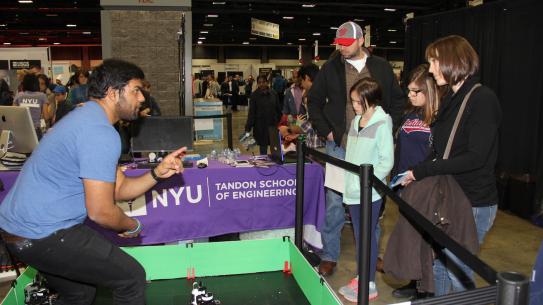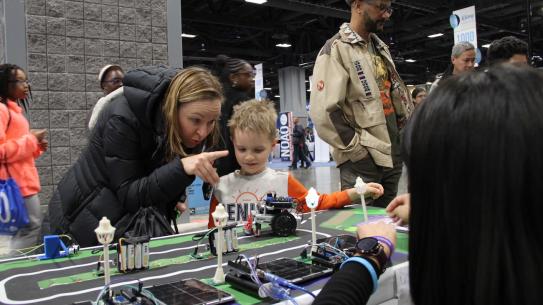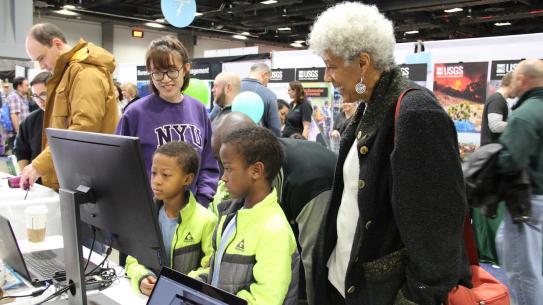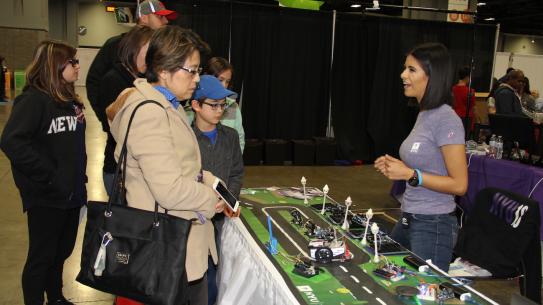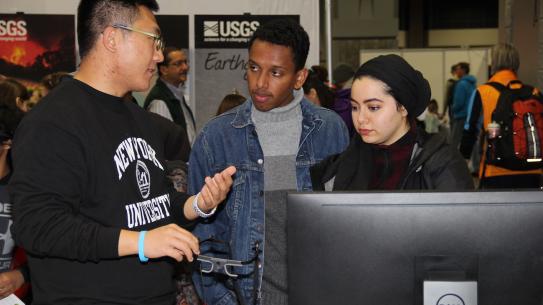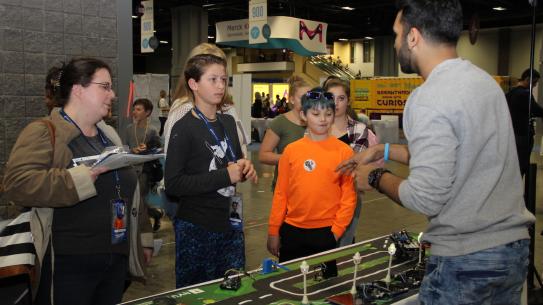A STEM-Powered Festival
Tandon Teams Headed to the Nation’s Capital to Showcase Their Tech
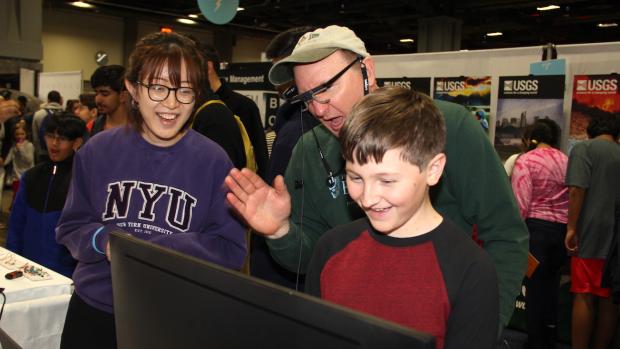
When the organizers of the USA Science & Engineering Festival put out the call for “dreamers, makers, thinkers, explorers, innovators, creators and star-gazers,” several NYU Tandon students and faculty members answered, traveling to Washington, D.C., in April to take part in what was billed as the country’s largest celebration of Science, Technology, Engineering and Math (STEM).
Their projects were among the more than 3,000 different hands-on activities and experiments on display at the event, which drew an estimated 350,000 people of all ages. Founded by entrepreneur Larry Bock and presented by Lockheed Martin to address the severe U.S. shortage in science and tech talent, the festival had as its theme: “Where Can STEM Take You?” The answers — in the case of Tandon — were into the cochlea of a hearing-impaired person, wandering a virtual environment that responds to physiological cues, in the midst of a swarm of robots, at the helm of an augmented-reality experience, and in the heart of an energy-efficient smart city, among other places.
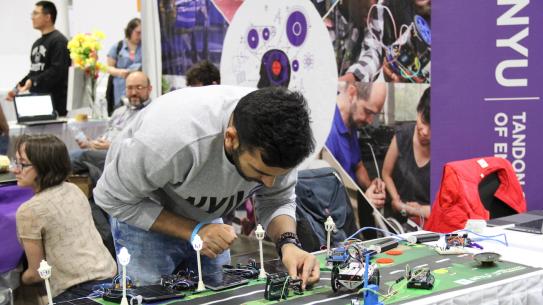
Student Teams
Diana Lee Guzman and Arhant Jain (Center for K-12 STEM Education): “We demonstrated projects from a few of Tandon’s K-12 programs, including ‘Science of Smart Cities’ and ‘Creativity in Engineering, Science, and Technology.’ The world is becoming increasingly urbanized, so we wanted to give people an idea of what’s involved in planning a smart, connected city. We brought along a robot capable of being guided by infrared light sensors along a pathway, and we created smart lamps that turned on when the robot passed them; we also incorporated an automated gate by using a Ping sound wave sensor that responded to the presence of objects nearby. Visitors had a lot of fun with it.”
Saiprasanth Krishnamoorthy and Sridhar Cuddalore Parthasarathy (Mechanical and Aerospace Engineering): “We showcased a swarm of small decentralized robots, which means that they’re untethered to a communications network. They can still work together in formation though, which makes them potentially useful in applications like search-and-rescue or exploration. They also provide a useful way to study human-robot interaction, which we’re going to be seeing more of as the field advances.”
Siyuan Qui and Woo Jae Park (Technology, Culture, and Society): “We’re active in the Mobile Augmented Reality Lab, and wanted to show visitors to the festival the potential of AR, which is really going to impact how we all interact with digital media and the world. The ARCreator we showcased allowed users to set their imaginations free, create AR objects with a simple voice command, and manipulate those objects. It was an entirely novel experience for many people.”
Roozbeh Soleymani (project lead) and Benjamin Cowen (Electrical and Computer Engineering): “This research was conducted along with Tandon Professor of Electrical and Computer Engineering Ivan Selesnick and Professor David M. Landsberger at the NYU School of Medicine, and it focuses on improving software for cochlear implant devices. It involves an innovative algorithmic noise-reduction technology called SEDA (Speech Enhancement using Decomposition Approach), which breaks down a speech signal into separate waveforms, allowing users of cochlear implants and hearing aids to better discern what someone is saying to them in crowded or noisy places. During the event, we met many people with hearing impairment, and they had a deep appreciation for what we were doing.”
Zhengbo Zou and Celia (Xinran) Yu (Civil and Urban Engineering): “We’re students of Professor Semiha Ergan, and our work explores ways to quantify what people feel and experience in different configurations of architectural spaces. The work utilizes biometric sensors and realistic virtual reality models to measure how our bodies and mind respond physiologically to changes in architectural design settings. This work will prove useful to architects and designers to improve the design of future built environment that enhance human experience. The work is also part of a larger vision where the building systems act intelligently to make adjustments in the space settings depending on emotional status of habitants. We set up a 27-inch screen and X-Box controllers so that festival-goers could experience a simplified version of the virtual environments we have in the lab, and it was great to see people getting excited about the possibilities of smart and responsive buildings.”
Tandon Faculty and Staff
Ben Esner (Director of the Center for K-12 STEM Education): “It’s an important experience for our students to present their work to a diverse audience of varying ages. They see firsthand that explaining their science, technology, and engineering to a first-grader or middle school student is obviously different from discussing it with a fellow engineer or scientist. Learning to adjust language, terminology, and jargon to your audience is a critical skill, whether our students ultimately join companies, become entrepreneurs, or remain in academia. Knowing how to distill complex STEM topics so that they’re understandable to laypeople is immensely valuable to them and to society.”
Vikram Kapila (Professor of Mechanical and Aerospace Engineering): “We hope that our exhibits opened festival visitors’ eyes to the important work being done at NYU Tandon. If we sparked a love of science and a desire to further explore the STEM fields in attendees, our participation will have been rewarded.”
Mark Skwarek (Lecturer of Integrated Digital Media): “I’m the founder of NYU’s Mobile Augmented Reality Lab, and my students are always eager to get out and demonstrate their projects. Because AR is an emerging technology, it’s new and exciting to everyone, so I think we all fed off the energy of being among so many thousands of people at the festival and getting their reactions to our work.”


